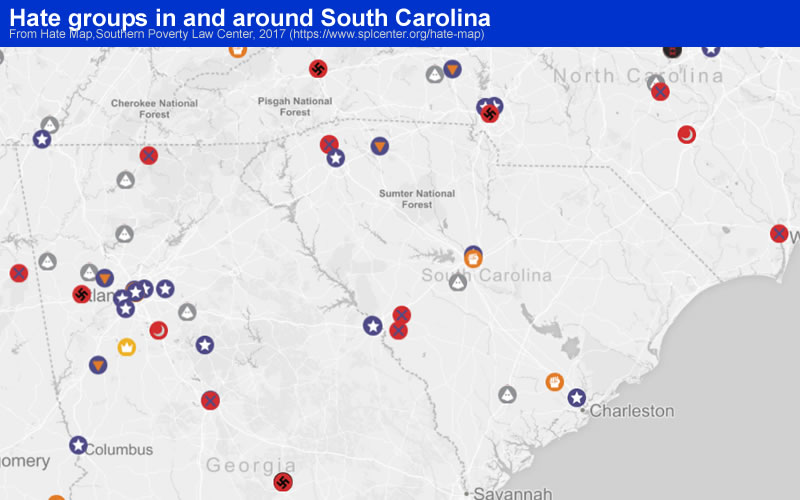
By Andy Brack, editor and publisher | Ten years ago, South Carolina was littered with real-life hate groups – 43, according to the Southern Poverty Law Center in Alabama. These days, the number is down to a dozen.
At one point, South Carolina had the highest per capita number of hate groups in the United States, according to Heidi Beirich, intelligence policy director at the Center.
“South Carolina was a place where they had actual buildings – they had a store.”
But infighting at the largest group, the League of the South, and its hardening of secessionist positions led thousands to fly the coop. In 2006, the league had 27 chapters in South Carolina. Now it has one, according to the Center’s Hate Map. The state still has outposts for other organizations classified as hate groups, including the Nation of Islam (Greenville and Charleston), the Ku Klux Klan (two groups, one statewide and one in Walterboro) and an anti-LGBT church in Spartanburg.
But the dramatic drop in the number of physical hate groups in the Palmetto State doesn’t necessarily mean there’s less hate. In fact, thanks to the Internet, there may be more that is simmering under a surface stunted by racism that sucked energy and life from the American South for generations.
“The world of hate has moved online, just like everything else,” Beirich said. “There are more than 300,000 users of Stormfront [a white nationalist website]. Whenever I talk about hate groups, it’s not capturing what’s happening online, which is where most of it is happening now.”
Case in point: South Carolina’s own Dylann Roof, who murdered nine people worshipping at Emanuel AME Church in Charleston in June 2015.
“That happened right in your backyard,” Beirich said. “He was never a member of any hate group. He learned everything about hating black people from the web.
“Dylann Roof was radicalized online and that makes him just like a lot of ISIS killers who have no connection to the Islamic State.”
Every 34 days, Beirich said, there’s some sort of attempted or achieved domestic terror attack by white supremacists, Beirich said, pointing to a 2015 study, Age of the Wolf: A Study of the Rise of Lone Wolf and Leaderless Resistance Terrorism.
“Among the study’s primary findings were that almost three-quarters of the incidents were carried out, or planned, by a lone wolf, a single person acting without accomplices,” according to a summary. “Ninety percent of the incidents were the work of no more than two persons. “
State Law Enforcement Division Thom Berry said the agency monitored online hate.
“SLED works closely with our fellow law enforcement partners at both the local and federal level to gather information on these groups,” he told Statehouse Report. “It would be inappropriate, though, to discuss any specifics of our work in this area.”
His boss, SLED Chief Mark Keel, urged South Carolinians to be careful when using the Internet.
“We have to remember there’s a dark side as well,” he said in a statement. “There are many examples of people taken advantage of by unscrupulous people posing to be something or someone they’re not. This can be financially or personally devastating.
He urged citizens to use common sense and careful when using the Internet.
“Be skeptical. Don’t give out personal information to someone you know only by a web address or a screen name. The person on the other end may not be who you think they are.
“The same is true for online groups. Don’t be lured by the graphics, interactivity or what may be on the surface an appealing message. Online groups can be very influential on our children. Parents should be involved and aware of their children’s online activities.”
For generations, people in South Carolina and other Southern states have been manipulated by politicians and leaders through the language and symbols of hate. But with the Internet, the sharpies of hate are trying to influence people directly and bypass the middlemen. Just as Keel warns, be careful. We don’t need any more Dylann Roofs.
Andy Brack is editor and publisher of Statehouse Report. Have a comment? Send to: feedback@statehousereport.com.















 We Can Do Better, South Carolina!
We Can Do Better, South Carolina!